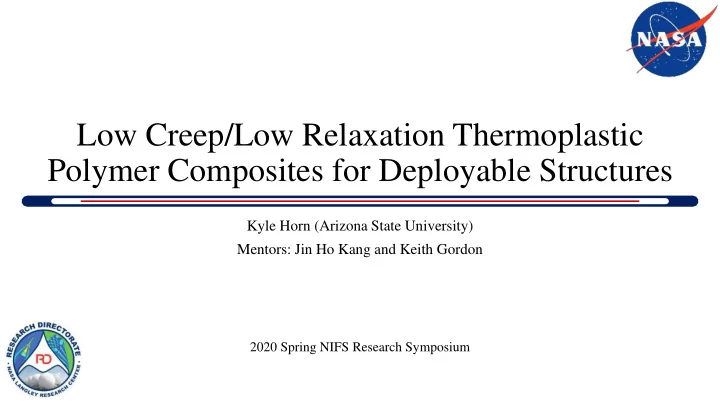

Low Creep/Low Relaxation Thermoplastic Polymer Composites for Deployable Structures Kyle Horn (Arizona State University) Mentors: Jin Ho Kang and Keith Gordon 2020 Spring NIFS Research Symposium
Problem Key Term – Stress Relaxation: the time-dependent decrease in stress of a viscoelastic material held under constant strain ❖ Deployable structures spend up to one or two years in stowage before deployment ❖ Can result in loss of structural integrity if Prolonged significant relaxation occurs Stowage 16 mm ❖ Need to mitigate stress relaxation within 23 mm ultralightweight carbon fiber / polymer composites Fig. 1. About 50% loss in buckling ❖ Current investigations in thermosets have strength due to stress relaxation [1]. Image credit: NASA yielded significant progress for BMI matrices 2 NASA Langley Research Center 2020 Spring NIFS Symposium Advanced Materials and Processing Branch
Objective Driving Question: What progress can be made in reducing the relaxation modulus of carbon fiber / polymer composites? ❖ Investigate thermoplastics for use as a matrix material in low- relaxation carbon fiber composites ❖ Characterize Polyether-Ether-Ketone (PEEK) to fabricate samples of CF/PEEK composites ❖ Benefits of PEEK ❖ One-step cure process ❖ Out-of-autoclave ❖ Reusability ❖ Strong fiber-matrix interface adhesion 3 NASA Langley Research Center 2020 Spring NIFS Symposium Advanced Materials and Processing Branch
Approach ❖ Layup ❖ Three layers polyimide release film bookends sample ❖ 1.5” X 2.5” mold ❖ 4 layers ❖ CF to PEEK ratio / layer ❖ CF: 1 ply CF weave @ 62 gsm ❖ PEEK: 4 plies PEEK foil @ 8 μ m thick / ply Fig. 2. Process conditions for CF/PEEK sample fabrication ❖ Processing conditions ❖ Apply pre-holding pressure of 1.2MPa ❖ Heat layup to 400 ° C @ about 5.5 ° C/min ❖ Apply 5MPa at temp 400 ° C ❖ Hold 10 min ❖ Decrease temp @ about -5.5 ° C/min Fig. 3. schematic of film stacking process ❖ Release pressure when layup temp < 66 ° C for consolidation of CF/PEEK sample 4 (not to scale) NASA Langley Research Center 2020 Spring NIFS Symposium Advanced Materials and Processing Branch
Results KH 00280-33-1 Fig. 6. KH 00280-31-1 Fig. 4. CF/PEEK [ 45 PW 2 /0-90 PW 2 ] PEEK Pristine KH 00280-32-1 Fig. 5. CF/PEEK [ 45 PW] 4 KH 00280-34-1 Fig. 7. CF/PEEK [0-90 PW] 4 Fig. 4 – 7. Successfully fabricated samples of PEEK Pristine, CF/PEEK [ 45 PW] 4 , CF/PEEK [ 45 PW 2 /0-90 PW 2 ], CF/PEEK [0-90 PW] 4 , respectively 5 NASA Langley Research Center 2020 Spring NIFS Symposium Advanced Materials and Processing Branch
Analysis JK242-66-1 APTIV 1000-PEEK-AS-2 Table 1. Carbon Fiber Mass Fractions Non-Reversing Heat Flow (Normalized) (W/g) Midpoint: 151.04 ° C Reversing Heat Flow (Normalized) (W/g) Enthalpy (normalized) 𝑛 𝑔 = 𝜍 𝐵 ∗ 𝐵 ∗ 𝑜 𝐷𝐺 34.652 J/g CF 𝑛 𝑔 Sample Mass [g] 𝑛 𝑡 Onset x: 308.70 ° C [ 45 PW] 4 0.9330 64.3% 𝑛 𝑔 = mass fraction 𝜍 𝐵 = areal density 1 st Heating [0-90 PW] 4 0.9116 65.8% 𝐵 = area 𝑜 = number of layers 𝑛 𝑡 = total post-fabrication [ 45 PW 2 /0-90 PW 2 ] 0.8999 66.7% mass of sample Peak Temperature: 338.68 ° C ❖ Typical CF mass fraction: 60% - 70% ❖ Suggests low void content Temperature ❖ Low void content tends to improve fiber-matrix Fig. 8. DSC thermogram of PEEK interface adhesion ❖ Differential Scanning Calorimeter (DSC) data ❖ Need SEM & acid digestion for confirmation shows a glass transition temperature of 151 ° C and a melting onset temperature of 309 ° C. ❖ All results are as expected ❖ Upper limit of application temperature for CF/PEEK composites 6 NASA Langley Research Center 2020 Spring NIFS Symposium Advanced Materials and Processing Branch
Summary ❖ Easy one-step cure process ❖ Total process takes ~6 hrs to complete ❖ 4 CF/PEEK composite samples were fabricated successfully in unique ply orientations for deployable structures ❖ All mass fractions were within typical ranges for carbon fiber polymer composites ❖ SEM data is needed to verify void content and completeness of individual fiber coatings 7 NASA Langley Research Center 2020 Spring NIFS Symposium Advanced Materials and Processing Branch
Next Steps ❖ COVID-19 impacted research efforts at week 8 of investigation ❖ ~3 weeks in-lab time required for relaxation testing on DMA ❖ Fabrication of subscale demonstration specimens ❖ Long term TRAC boom stowage test comparing reduction in creep/stress relaxation for BMI thermoset and PEEK thermoplastic Fig. 8. Future work of comparing the relaxation in Triangular Rollable And Collapsible (TRAC) booms between CF/PEEK and CF/BMI composites illustrated [1]. Image credit: NASA 8 NASA Langley Research Center 2020 Spring NIFS Symposium Advanced Materials and Processing Branch
Acknowledgements Special Thanks to: ❖ Steve Lee & Janeene Sevilla for safety and lab trainings ❖ Jeff Hinkley & Sheila Thibeault for providing ideas and solutions to key problems during biweekly update presentations ❖ Christine Dillard, Valerie Ellis, Patricia Sanchez, & Jalisa Thomas for coordinating the internship program ❖ Brandon Fallon & Jynette Tigner for lab help, constructive criticism, and making the internship experience overall more fun ❖ Hoa Luong, Johnny Fernandez, Kevin McClain, Keats Wilkie, Phil Brown for sample supply, support and process Figure References: [1] J . M. Fernandez et al., “An Advanced Composites - Based Solar Sail System for Interplanetary Small Satellite Missions,” in 2018 AIA A Spacecraft Structures Conference, Kissimmee, Florida, 2018, doi: 10.2514/6.2018-1437. 9 NASA Langley Research Center 2020 Spring NIFS Symposium Advanced Materials and Processing Branch
Recommend
More recommend